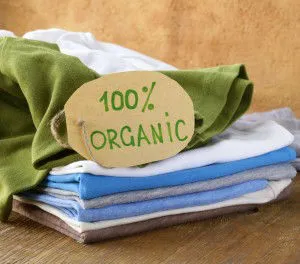
- Share on Facebook48
- Share on Pinterest
- Share on Twitter
When most people think of “going organic,” food is the only area of life that comes to mind. However, choosing organic clothing is also an important decision, both for your overall health, the health of the environment, and to support sustainable agriculture and fair working conditions.
Think about it: the clothes you wear are in contact with your skin for the great majority of the day. Our bedsheets, blankets and towels also play a significant role in our daily lives. The materials used for these items are often synthetic fabrics, or cotton.
In 2008, the United States alone produced over 9 trillion pounds of cotton. While choosing cotton clothing and linens seems like the obvious choice over synthetic fabrics, unless your cotton (and other fabrics, for that matter) are organic, they come with some pretty significant pitfalls.
The following are five reasons to seriously consider switching to organic clothing, as well as organic fabrics for your household.
No pesticide exposure
Conventional cotton is grown using an extremely large amount of pesticides, herbicides, insecticides and fungicides. In fact, the cultivation of cotton utilizes about 25 percent of all the chemical pesticides in the world, while occupying only three percent of its agricultural land.
Many of the top pesticides used on cotton crops are classified as “likely” or “known” carcinogens by the EPA. Exposure to the pesticides used on these and other crops have been linked to side effects including weakened immunity, as well as hormonal and reproductive imbalances.
The major risks of exposure to these pesticides are suffered by the farm workers, who pick the cotton by hand in some countries. Improper storage and handling of the chemicals can lead to accidents resulting in paralysis or even death. Furthermore, they often leach into nearby water supplies.
Organic cotton, on the other hand, is grown without the use of pesticides or synthetic fertilizers, making it the safer and healthier choice all-around.
No GMOs
Approximately 75 percent of conventionally-grown cotton is genetically modified. The cultivation of genetically modified crops is thought by many experts to be potentially dangerous, both for human health and the health of the environment.
While you may think it’s not a big deal, since most of this genetically modified cotton is not actually consumed, some of it is. The feed used for a great deal of cattle in the United States contains cottonseed, which then leads to GMOs in our beef and our milk.
Furthermore, cottonseed oil is used in many processed foods – just one more reason to steer clear of these. Organic cotton is, by law, grown from seeds that have not been genetically modified.
Avoid potential skin irritants
When clothing and linens made from conventional cotton are processed, they undergo chlorine bleaching, as well as exposure to formaldehyde resins and dyes containing heavy metals. These processing methods can leave the resulting fabric quite irritating to sensitive skin, potentially leading to allergic reactions including itchy dermatitis.
Clothing made from organic cotton and other organic fibers, on the other hand, is processed using non-chlorine bleach, azo-free dyes and softeners without silicon. These fabrics are much less likely to trigger skin reactions, and may be the only comfortable option for those with highly sensitive skin.
Sustainable practices
Organic cotton is grown without the use of pesticides and chemical fertilizers, and instead uses sustainable methods, such as weeding machinery, to reduce the impact of growing cotton on the environment. Crop rotation is employed to maintain the fertility of the soil, and beneficial insects are used to control pests that may damage the crops.
These methods are much healthier for the environment, as they do not contaminate the surrounding area with pesticide residues, and much safer for the workers growing and harvesting the cotton.
Better labor conditions
Unfortunately, along with harming the environment, some conventional cotton operations exploit their workers and do not create humane conditions for them to operate in. According to the 2010 Global Organic Textile Standard, organic cotton operations require employers to pay fair wages, set reasonable working hours and guarantee safe and humane working conditions. Employees of these operations also have collective bargaining rights.
Additionally, small-scale organic cotton farmers save money, as they do not have to purchase pesticides to spray onto their fields.
 Next time you are in need of new threads, consider organic materials. It may cost a bit more, but the contribution to the planet is significant.
Next time you are in need of new threads, consider organic materials. It may cost a bit more, but the contribution to the planet is significant.
If more people switched to products made from organic cotton, the price may eventually be substantially lower, and conventional operations, which douse their genetically modified crops in chemicals, would have some serious competition.
-The Alternative Daily
Sources:
http://homeguides.sfgate.com/advantages-organic-clothing-78387.html
http://www.motherearthnews.com/nature-and-environment/organic-cotton-benefits.aspx#axzz3AXKcxTOJ
http://www.haenow.com/cart/whyorganic.php
- Share on Facebook48
- Share on Pinterest
- Share on Twitter

